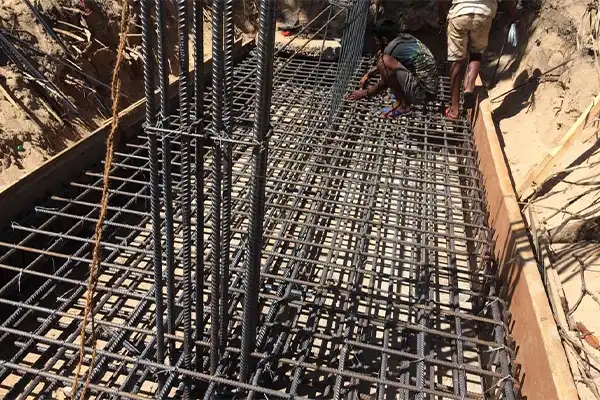The foundation is a strong base that supports the entire structure by distributing its weight evenly across the ground beneath it. Generally, there are two types of foundations: shallow and deep. Shallow foundations are used when the surface ground is solid.
Several kinds of shallow foundations exist, including mat foundations, isolated footings, combined footings and strip footing.
Choosing the proper foundation is similar to choosing the best support for a building; it depends on the structure’s weight, the state of the ground, and particular construction specifications. A structure’s long-term strength and stability depend critically on carefully selecting a foundation.
In shallow foundations, strip footings are often used in residential and small commercial constructions.
In this blog, Brick&Bolt gives a detailed information about strip footing, its types, suitability, advantages, and disadvantages of strip footing.
Now, let’s delve into the journey …
What is Strip Footing?
Strip footing, continuous footing or wall footing or strip foundation is a type of shallow foundation commonly used in construction. It is a long, continuous concrete strip that supports the load of a wall or a row of columns. The strip footing is typically reinforced with steel bars to enhance its strength.
Strip foundations are good because they spread the weight well, save money, and work well in different soils. In India, they can be a good choice if the soil, climate, and specific needs of the construction project are considered. Having professionals for design and construction, along with checking the ground, is important for successful strip foundations in India.
When is strip footing used?
Strip footing is commonly used for load-bearing walls and when the soil has a high bearing capacity. It is recommended for low- to medium-rise residential buildings. In this instance, the load is distributed from the walls to the ground by a concrete strip that runs underneath the whole length of the wall. This increases the stability of the building. The footing should, therefore, be at least twice as wide as the wall. A row of columns spaced closely together can occasionally be supported by strip foundations. In this instance, continuous footings would be less expensive than spread footings that overlap.
If the soil’s bearing capacity is low, broader strip foundations might be required. In these situations, plain concrete might not be enough, it requires a reinforced concrete strip foundation. The state of the soil determines the precise width of the load-bearing wall and footing. The structural engineer ought to be qualified to provide advice based on the results of the soil tests conducted on your plot.

Types of Strip Footing
There are two varieties of strip foundations based on their qualities, and they are as follows:
- Deep Strip Footing
- Wide Strip Footing
In this blog, Brick&Bolt gives a detailed information about strip footing, its types, suitability, advantages, and disadvantages of strip footing.
Now, let’s delve into the journey …
Deep Strip Footing
A deep strip footing is the most common type of strip footing, and it works best on soil that is well stabilised. Strips of reinforced concrete support the walls. Although the depth of the groove is subjective, it should be at least 24 inches broad and 40 inches deep. There should be at least nine inches of concrete.
Wide Strip Footing
Wide strip footings are found when the soils have a low bearing capability. A regular strip footing cannot be installed on poor-quality soil. It is not economically justified to overridden or deepen a structure in order to avoid tearing down barriers. Reinforced concrete can be a good option for the foundation. For the whole structure to sustain stress and compression, reinforcing bars give foundations tensile strength.
Suitability of Strip Footing
Strip footings are chosen based on particular project requirements and construction scenarios.
Several factors impact the suitability of strip footings, including
- Load Distribution: Wall footings are an excellent choice when a wall or row of columns must be supported evenly over a large soil area. This guarantees that the weight is sufficiently supported without putting unnecessary strain on any area.
- Continuous Support: As continuous, extended structures, strip footings provide continuous support along the length of a load-bearing wall. This constant support is beneficial for maintaining stability and preventing differential settlement.
- Construction Simplicity: Strip footings are economical and practical for many projects because of their simple design and construction. Their ease of use makes them ideal for simple applications on building sites.
- Adaptability to Soil Conditions: The design of strip footings can accommodate different soil conditions. Based on the bearing capacity and properties of the underlying soil, engineers can modify the strip footing’s dimensions and reinforcement.
- Closely Spaced Columns: Strip footings are a practical solution when columns are closely spaced apart, and separate footings for each column would cause overlap or interference. In such cases, they provide a cost-effective and space-efficient solution.
- Suitability for Expansive Clay Soils: Because of their T-shaped cross-section, inverted or trough strip footings work well in expansive clay soils. In such soil conditions, this design aids in mitigating the effects of swelling and shrinking.
- Architectural Freedom: The versatility of strip footings permits architects to be creative with their layout designs and accommodate closely spaced columns without sacrificing the stability of the foundation.
Advantages of Strip Footing
The following are the main benefits of using strip footings:
Load Distribution:
Strip footings ensure stability by uniformly distributing a structure’s weight over a larger area, preventing isolated soil settlement.
Cost-Effectiveness:
Strip footings can be a more economical option than individual footings for every column, particularly when columns are closely spaced.
Versatility:
Strip footings are adaptable to various soil types and load-bearing specifications, making them appropriate for multiple construction projects.
Ease of Construction:
Strip footing construction is frequently simple, which improves building process efficiency. Time and money can be saved as a result of this simplicity.
Space Utilisation:
The continuous strip footings maximise available space and make it possible to arrange load-bearing walls and columns effectively.
Structural Stability:
Strip footing’s long, continuous design improves structural stability by offering dependable support along the load-bearing elements.
Flexibility in Design:
Engineers can choose from different types of strip footings, such as deep or wide, based on the project’s unique requirements.
Reduced Risk of Overlapping:
In closely spaced columns, strip footings help avoid overlapping issues that may arise if individual footings are used.
Disadvantages of Strip Footing
The following are some key disadvantages of strip footings:
Limited Load-Bearing Capacity:
Strip footings may have limitations regarding the maximum load they can support. Other foundations might not be more appropriate for large structures or heavy weights.
Challenges in Alterations:
Renovations and changes to the building layout can be challenging because modifying or altering the structure supported by strip footings can be more complicated.
Not Ideal for Tall Structures:
In the case of tall or high-rise structures, the relatively small size of strip footings might not provide adequate support against potential settlement or tilting.
Site-Specific Challenges:
Site-specific challenges, including environmental factors and potential changes in soil conditions over time, can influence the suitability of strip footings.
In conclusion, strip footings provide durability, stability and even load distribution for various structures, making them an essential and commonly used foundation solution in the construction industry. Due to their versatility, they are appropriate for various building types.
To ensure a sturdy foundation, strip footing design considers variables like soil bearing capacity, load distribution, and structural requirements.
Strip footings are a helpful solution, but it’s important to be aware of potential drawbacks like challenges in alteration and site-specific conditions. Strip footings are successfully implemented when these factors are carefully considered and engineering best practices are followed.

